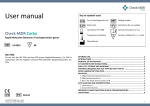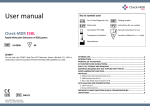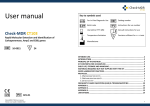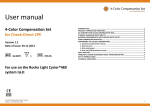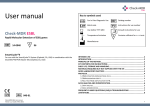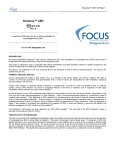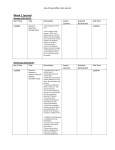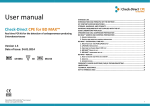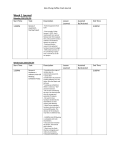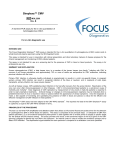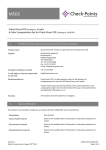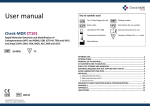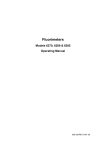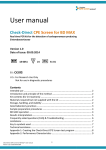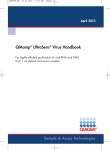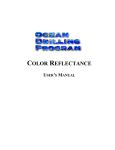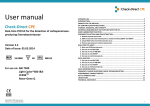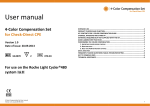Download User manual - Check
Transcript
User manual Check-MDR Carba Key to symbols used For In Vitro Diagnostic Use Catalog number Batch code Instructions for use number Use before YYYY-MM Consult instructions for use Temperature limitation Contains sufficient for < n > tests Rapid Molecular Detection of carbapenemase genes Manufacturer 14-0051 24 LightCycler® 480 For use with the LightCycler® 480 real-time PCR system (Roche, CH) in combination with the QuantiTect® Probe PCR Master Mix (QIAGEN, CA, USA). INTENDED USE .................................................................................................... 2 INTRODUCTION .................................................................................................. 2 PRINCIPLE OF THE METHOD ................................................................................ 2 KIT CONTENTS (FOR 24 REACTIONS) .................................................................... 2 SHELF LIFE, STORAGE AND HANDLING ................................................................. 2 MATERIALS REQUIRED BUT NOT SUPPLIED WITH THE KIT .................................... 3 GOOD LABORATORY PRACTICES .......................................................................... 3 PROTOCOL.......................................................................................................... 4 1. DNA EXTRACTION FROM BACTERIAL CELLS ................................................................... 4 2. DNA RECOGNITION STEP A ....................................................................................... 4 3. REAL-TIME PROBE AMPLIFICATION STEP B .................................................................... 5 DATA ANALYSIS AND INTERPRETATION ............................................................... 6 1. DATA ANALYSIS ....................................................................................................... 6 2. DATA INTERPRETATION ............................................................................................. 6 FREQUENTLY ASKED QUESTIONS (FAQ) & TROUBLESHOOTING ............................ 7 LIMITATIONS ...................................................................................................... 8 051-01 Check-MDR CARBA User manual Version 1.1, Issued 25 Sept 2012 1 Intended use Principle of the method Check-MDR Carba is designed for the rapid molecular detection of the clinically important carbapenemase genes in gram-negative bacteria: KPC, NDM, OXA-48, VIM and IMP. CheckMDR Carba generates definitive results within 4.5 hours, compared to the 24 hours necessary for analysis with conventional phenotypic methods. Check-MDR Carba is based on specific molecular recognition of target sequences by DNA probe ligation followed by real-time PCR detection. The recognition step uses two specific oligonucleotides (ligation probes) that are joined by a DNA ligase only when they match perfectly with the target DNA. In addition to target-specific sequences, the DNA probes contain two universal primer binding sites as well as a DNA segment that is complementary to a molecular beacon. Subsequent real-time amplification with universal primers is used to detect the connected probes, and their accumulation is visualized by fluorescence of a molecular beacon Introduction In the last decade various carbapenemases have been reported which cause elevated or complete resistance against carbapenem antibiotics when produced by bacteria. Strains carrying genes encoding such enzymes are generally resistant to all β-lactam antibiotics. They often contain additional β-lactamase genes and genes for resistance against quinolones and aminoglycosides. The carbapenemase genes detected with Check-MDR Carba include: 1) KPC, Klebsiella Pneumoniae Carbapenemase, an Ambler class A carbapenemase first identified in K. pneumoniae isolates in North America and now found in many countries worldwide in various other enterobacterial species including E. coli; 2) NDM, New Delhi Metallo-β-lactamase (NDM) first reported in 2009 in Sweden in both K. pneumoniae and E. coli, nowadays regularly found in various European countries and quite prevalent in India and Pakistan; 3) OXA-48 carbapenemase, a class D β-lactamase originating from Shewanella species, and regularly found in Europe, North Africa and Turkey in fermenting Enterobacteriaceae like E. coli and Klebsiella; and 4) VIM & IMP carbapenemases, metallo-β-lactamases first reported in Pseudomonas aeroginosa (VIM-1 in Verona in 1997 and an IMP-1 in Japan in 1990), and since then transferred to E. coli and K. pneumoniae and many other Enterobacteriaceae. Many gene variants of VIM and IMP exist of which the DNA sequences may differ significantly and, therefore, VIM and IMP should be regarded as two separate gene families of homologous gene variants. Conventional methods for detection of β-lactamases rely on phenotypic identification which is time-consuming, frequently inconclusive and not applicable to all species. Check-MDR Carba is a rapid molecular test for the detection of the most prevalent carbapenemase genes. Check-MDR CARBA User manual Version 1.1, Issued 25 Sept 2012 Kit contents (for 24 reactions) Components (Mat. No.) Description Storage conditions Solution A (9-0050) 1 tube (purple cap ) 600 μl - 20°C Solution P Carba (9-0052) 1 tube (green cap ) 250 μl - 20°C Solution R (9-0063)* 1 tube (yellow cap ) 250 µl - 20°C, store in the dark Internal control (9-0054) 1 tube (transparent cap ) 500 μl - 20°C Positive control Carba (9-0056) 1 tube (white cap ) 500 μl - 20°C Manual (9-0058) Leaflet – download from website Not critical * Volume provided for 25 reactions which takes into account the preparation of excess master mix. Shelf life, Storage and Handling The components of the kit must be stored at -20°C. Solution R has to be stored in the dark. Reagents stored at the appropriate storage conditions can be used until the expiration date. Please visually inspect the box upon initial opening to ensure that its content is intact. Do not use when damaged. Please contact the Check-Points office at [email protected] if you have any questions or in case shipping has taken more than 2 days. 2 Materials required but not supplied with the kit Equipment Pre-PCR Post-PCR Thermocycler* Vortex mixer Mini-centrifuge PCR plate spinner Real-Time PCR instrument* QuantiTect® Probe PCR Master Mix DNA extraction procedure** Disposable laboratory (powder-free) gloves Pipettes & disposable (filter-) tips for volumes of 1 to 1000 µl Supplies 1.5 ml tubes (“Eppendorf tubes”) 10 ml tubes (for large volumes) 96-well PCR plate PCR plate seal PCR tubes/strips *contact your local representative for specifications. **see Protocol, section 1 Good laboratory practices Prevention of contaminations PCR produces a very high quantity of DNA amplification products (amplicons) even from minute quantities of starting material. Check-MDR Carba may therefore yield unreliable results if samples become contaminated with amplicons from previous amplification reactions prior to the PCR. Preventive measures to minimize the risk of amplicon contamination must be taken. Please read carefully and follow the instructions outlined below. Use separate rooms: a pre-PCR room and a post-PCR room. To keep laboratory free of PCR product contamination: Recommendations for best results The quality of the results depends on strict compliance with the following good laboratory practices, especially concerning PCR: The test must be performed by adequately trained personnel. Spinning down for a few seconds is done in the various steps to ensure that all material is collected at the bottom of the tubes. Do not use reagents after their expiration date. Before use, thaw frozen reagents completely at room temperature and vortex briefly to obtain a homogeneous solution. After vortexing briefly, spin down the solution to avoid contamination when opening the lid. Avoid unnecessary freezethawing of the kit content. Periodically, verify the accuracy and precision of pipettes, as well as correct functioning of the instruments. Keep Solution R (yellow cap ) in the dark to avoid photo-bleaching of the dyes. Check-MDR CARBA User manual Version 1.1, Issued 25 Sept 2012 Sample preparation, DNA recognition (step A) and preparation of the amplification step (step B) is carried out in the pre-PCR room. Incubation in the real-time PCR thermocycler of step B is carried out in the postPCR room. Never bring the reaction products of step B to the pre-PCR room. Never prepare the ligation and/or amplification steps in the post-PCR room. Use pipettes with hydrophobic filter tips. Make sure to always use a new pipette tip when adding solutions or samples to a reaction tube to avoid contamination. Follow proper pipette-dispensing techniques to prevent aerosols. Use separate equipment, pipettes, thermocyclers, sample holders, lab coats, gloves, disposables and reagents, that are assigned to these rooms. Never transfer items from the post-PCR room to the pre-PCR room. Wear a clean lab coat and clean gloves during all steps of the test. Wear clean gloves and a clean lab coat not previously worn while handling amplified PCR products or during sample preparation. Change gloves whenever you suspect that they are contaminated. Keep the tubes of all kit components and samples closed as much as possible. Clean the lab benches and all equipment regularly with a 0,5% sodium hypochlorite solution. 3 Protocol MagNA Pure system (32 samples) (Roche, CH) for DNA extraction procedure for clinical specimens. Use 200 µl of cell suspension in PBS, Phosphate buffered saline, McFarland 0,5 – 1,0 or OD600 0,08 – 0,12 (this may vary between spectrophotometers). Add 2,5 µl of the IC solution (transparent cap ) to the cell suspension and start the DNA extraction. DNA is eluted in 100 µl elution buffer. DNA extracts should be stored at +4°C only, for up to 6 months. 2. Use the DNA solution directly and continue with “step A” or store as specified until use. It is strongly recommended that the full protocol is read before using the test. The protocol consists of the following steps: 1. 2. 3. DNA extraction from bacterial cells DNA recognition step A Real-time probe amplification step B 1. DNA extraction from bacterial cells Important points before starting: DNA extraction is completely carried out in the pre-PCR room. Make sure to always use a new pipette tip when adding solutions or samples to a reaction tube to avoid contamination. Clinical specimens should first be incubated on nutrient agar plates. Use bacterial cells from these agar plates for DNA extraction. Typical growth media include blood agar, MacConkey agar and Tryptic Soy agar. Procedure: 1. Check-MDR Carba has been validated with the following extraction methods for bacterial cells: NucliSENS® easyMAG® (bioMérieux, France) automated DNA extraction procedure for bacterial cells. Follow the manufacturer’s protocol for bacterial cells and use 200 µl cell suspension of McFarland 0,5 – 1,0 or OD600 0,08 – 0,12 (this may vary between spectrophotometers). Add 2,5 µl of the Internal Control solution (IC, transparent cap ) to the cell suspension and start the DNA extraction. DNA is eluted in 110 µl elution buffer. DNA extracts can be stored at -20°C or +4°C for up to 6 months. DNeasy Blood & Tissue Kit (QIAGEN, CA, USA) DNA extraction procedure for bacterial cells (manual extraction or QIAcube automated system). Follow the manufacturer’s protocol for gram-negative bacteria. Prepare 1 ml cell suspension of McFarland 1,2 – 1,8 or OD600 of 0,16 – 0,24 (this may vary between spectrophotometers) and centrifuge at 14000 rpm for 10 minutes. Discard the supernatant and add 5 µl of the IC solution (transparent cap ) to the pellet. Start the DNA extraction with the pelleted cells using either the manual procedure or the QIAcube automated procedure. DNA is eluted in 200 µl elution buffer. Store DNA extracts at -20°C or +4°C for up to 6 months. 2. DNA recognition step A Important points before starting: Step A is completely carried out in the pre-PCR room. Make sure to always use a new pipette tip when adding solutions or samples to a reaction tube to avoid contamination. It is advised to perform a positive and negative control reaction. The positive control (white cap ) is supplied with the kit; for the negative control we recommend to perform a DNA extraction as specified earlier (with IC solution) for a sample known to be negative for the test in use (i.e., Carba negative sample, elution buffer, clean water). Use a thermocycler located in the pre-PCR room to perform the step A reaction. Use PCR tubes that are suitable for the type of thermocycler used. Procedure: 1. Determine the number of reactions. Thaw all reagents (i.e. Solution A, DNA samples If kept at -20°C, and positive control), mix well and keep on ice. 2. Prepare the ligation reaction mix as described in table 1 and include 10% surplus to ensure that you have enough ligation reaction mix. Mix well and spin down. 3. To each tube add 7,5 μl of ligation reaction mix and 10 μl of sample DNA or controls (see table 2). 4. Close the tubes, mix well (by tapping or vortexing) and spin down briefly. The solutions should have a uniform blue color. 5. Place the tube(s) in the thermocycler and run the Probe ligation program, see table 3 (total sample volume ~ 18 μl). Table 1: Ligation reaction mix. Component Solution P Carba (green cap ) Solution A (purple cap ) Total volume of ligation reaction mix Check-MDR CARBA User manual Version 1.1, Issued 25 Sept 2012 Volume per reaction 2,5 µl 5 µl 7,5 µl 4 Table 2: Ligation reaction setup. 4. Reaction Type Component Volume per reaction Test sample Sample DNA 10 µl Positive control Carbapenemase positive (white cap ) 10 µl Negative control Negative sample extracted with the IC 10 µl 5. 6. 7. Table 3: Probe ligation cycling parameters. Note: Step Temperature Time Cycles 1. 95°C 3 min 1 2. 65°C 120 min 1 3. 98°C 2 min 1 4°C hold 8. It is recommended to mix Solution P and Solution A first in a separate tube for x number of samples (including controls and 10% surplus) and then add 7,5 µl of this mix to each reaction tubes. Prepare this mix shortly before step A is started and use immediately. Do not store this mix and dispose after use. Close the PCR tube(s) carefully: excessive pressure may distort the cap and lead the sample evaporation during step A. 3. Real-time probe amplification step B Important points before starting: The preparation of the reaction mix for step B is carried out in the pre-PCR room. Step B was developed for the real-time LightCycler® 480 (LC 480) instrument (Roche, CH), therefore Roche PCR 96-well plates and corresponding adhesive seals should be used (Roche, CH). Step B requires the QuantiTect® Probe PCR Master Mix (QIAGEN, CA, USA). Procedure: 1. Briefly spin down the reaction mixtures from step A. 2. Take Solution R (yellow cap ) from the freezer. Thaw completely at room temperature protecting from exposure to light. Mix well and spin down briefly. 3. Prepare the real-time PCR (qPCR) reaction mix as described in table 4 and include 10% surplus to ensure that you have enough qPCR reaction mix. Check-MDR CARBA User manual Version 1.1, Issued 25 Sept 2012 Add 25 µl of qPCR master mix and 5 µl of each step A reaction to each well of the 96well plate. Use a new pipette tip for each step A reaction sample added. Seal the plate, mix by tapping the plate on the bench and spin down briefly using a centrifuge with 96-well plate adapters. Transfer the plate to the post-PCR room. Following the manufacturer’s instructions, start and set up the run of the real-time PCR LightCycler® 480 instrument using the following parameters, see also table 5 and 6: Detection format: Multi Color Hydrolysis probe Reaction Volume: 30 µl No color compensation needed Analysis mode: quantification for the amplification step Integration time mode: Dynamic Analysis modules: Abs Quant/2nd Derivative Max for All Samples ("Abs Quant/2nd Der") Without delay, place the plate or strips into the real-time PCR instrument and start the run with the cycling conditions presented in table 6. When the run is completed, discard the plate according to local regulations. Table 4: qPCR-reaction mix. Component Volume per reaction Solution R ( yellow cap ) 10 µl QuantiTect® Probe PCR mastermix 15 µl Total volume of master mix 25 µl Table 5: Filter combination. Target Detector Carbapenemase FAM (483-533nm) Internal Control Cy5 (615-610nm) Table 6: Real-time cycling parameters Step Denaturation Amplification Cooling Temperature Time Cycles Acquisition mode Ramp rate 50°C 2 min 1 None 4,4°C/s 95°C 10 min 1 None 4,4°C/s 95°C 15 sec None 4,4°C/s 60°C 60 sec Single (FAM,CY5) 2,2°C/s 40°C Hold None 2,2°C 40 5 Data analysis and interpretation 3. LC 480 real-time PCR instrument For a detailed description on how to operate the LightCycler® 480 instrument and how to analyze your data, please refer to the LightCycler® 480 instrument operator’s manual. 4. 1. Data analysis 1. 2. In the Analysis Overview use Analysis modules: Abs Quant/2nd Derivative Max ("Abs Quant/2nd Der") for all samples. This process is described in the LightCycler® 480 instrument operator’s manual. Check the Amplification plot. Figures 1 shows typical amplification plots of Carbapenemase positive and negative samples. 5. 6. Positive carbapenemase samples will show a lower FAM Cp value than the Internal Control (IC) Cy5 signal. Positive Carbapenemase samples will be typed positive with an expected Cp value < 31. Negative carbapenemase samples will show a higher FAM Cp value than the IC Cy5 signal. Negative carbapenemase samples will show a Cp value > 35. In the results table the status will display “> - Late Cp call high uncertainty” or “detector call uncertain, Late Cp call” or No Cp value corresponding to a negative call. For negative carbapenemase samples, the IC Cy5 signal is expected at 33 ±2. Samples with a FAM Cp between 32 and 35 and a Cp for the IC Cy5 at 33 ±2 are considered inconclusive. Please repeat the whole procedure with a new DNA extract of the bacterial culture. If still inconclusive the sample can be regarded neither positive nor negative. In samples with a FAM Cp > 35 or no Cp and an IC Cy5 > 35 no Cp the assay has not worked well and should be repeated with a new DNA extract of the bacterial culture. Table 7: Criteria for a valid run with Check-MDR real-time assay. Reaction/Sample Type* Positive control Negative sample (extracted with IC) Carba (FAM) CP values Internal Control (Cy5) CP values 24 ±2 33 ±2 No Cp or Cp > 35 33 ±2 * IC: internal control; If CP values are not as expected, see FAQ Figure 1: Typical real-time amplification plots of: A FAM signal for carbapenemase positive (in red) and negative (in green) samples B Cy5 signal for carbapenemase negative and positive samples (in red). The internal control curve (Cy5) may be absent or at a higher CP in positive samples (Software release 1.5.0). 2. Data interpretation Interpret results (positive, negative or inconclusive) with the CP values obtained for the samples following the guidelines outlined below and summarized in table 7 and 8. 1. 2. Table 8: Data interpretation guidelines. Carba (FAM) Internal Control (Cy5) Cp values Cp values Interpretation < 31 > 32 Positive sample > 35 or no Cp 33 ±2 Negative sample 32 < CP < 35 33 ±2 Inconclusive > 35 or no Cp > 35 or no Cp Sample failed* * see FAQ. The relevant columns in the sample/results table are “Position”, “Name”, “Reporter”, “Cp” and “status”. All other columns may be ignored or removed from the table. Verify that the real-time PCR run is valid before data analysis and interpretation of the results. Table 7 shows criteria for a valid real-time run with Check-MDR Carba test. Check-MDR CARBA User manual Version 1.1, Issued 25 Sept 2012 6 Frequently asked questions (FAQ) & Troubleshooting 1. How important is the amount of input cells for DNA extraction? Check-MDR Carba has been optimized using a well-defined amount of cells. A deviation of 20% in the amount of cells will have no major consequences. Larger deviations will not give optimal results. 2. May other DNA extraction methods be used with Check-MDR Carba? Check-MDR Carba test has been optimized using DNeasy Blood & Tissue Kit (QIAGEN, CA, USA), NucliSENS® easyMAG® (bioMérieux, France), and MagNA Pure system (Roche, CH) extraction methods. Check-Points does not guarantee the performance of the test with extraction methods other than those recommended in this manual. 3. The thermocycler states an error in step A. Please contact Check-Points Technical Support: [email protected] 4. During the step A the sample(s) have (partly) evaporated. Reaction tubes may not have been closed properly. Please restart the procedure from step A. 5. I have left Solutions (A, P, R, Internal control or Positive control) out of the -20°C (4˚F) storage. These reagents must be stored at -20°C (-4°F) for proper performance of the test. The performance of the product cannot be fully guaranteed if these solutions were left out of -20°C (-4˚F) for more than 24 hours. 6. 7. May I change the Cp threshold when analyzing my real-time PCR data? The Check-MDR Carba assay was developed using the automatic “Abs Quant/2nd Derivative Max” calculation method from the LightCycler® 480 instrument software (release 1.5.0). We therefore strongly advise to use this method for data analysis. Please refer to the LightCycler® 480 instrument operator’s manual for more information. Check-MDR CARBA User manual Version 1.1, Issued 25 Sept 2012 8. What does it mean if the real-time results show no CP values or interpretation concluded that the sample failed? Such results may have multiple explanations: The sample DNA was not added to the assay in step A. The sample DNA tested with Check-MDR Carba is negative and the internal control was not added prior to DNA extraction. The DNA extraction failed since the internal control was not detected. The sample DNA contains contaminants inhibiting the reactions. Please repeat the DNA extraction. Solution P and/or Solution A was not added in step A. Please repeat the test. Solution R and/or TaqMan® Universal PCR MasterMix was not added to the assay. Please repeat the test. QuantiTect® Probe PCR Master Mix may have expired. 9. What does it mean if the real-time results show no CP values for the positive control or interpretation concluded that sample is inconclusive? Such results may have multiple explanations: The positive control solution was not added to its reaction tube in step A. Solution P and/or Solution A was not added in step A. Please repeat the test. Solution R or TaqMan® Universal PCR MasterMix was not added to the assay. Please repeat the test. QuantiTect® Probe PCR Master Mix may have expired. 10. Duplicate DNA samples tested with Check-MDR Carba test do not yield identical results. CT values of identical samples may vary slightly between individual reactions. Larger variations, > 2 Cp values, suggest pipetting errors or other differences between the duplicate samples. 11. May the assay be interrupted after step A and continued at a later time? Reaction mixtures from Step A can be kept at hold at +4°C for up to 2 hours. For further inquiries, please contact Check-Points Technical Support: [email protected]. 7 Limitations Check-MDR Carba uses a range of specific DNA markers to detect the presence of the carbapenemase genes KPC, NDM, OXA-48, VIM and IMP, which currently represent the clinically most prevalent carbapenemases. The test detects all presently known variants of KPC, NDM, OXA-48 and VIM, except VIM-7, a rare variant only found in Pseudomonas aeruginosa. IMP is the most diverse carbapenemase gene family, and the test detects the clinically most important IMP-variants in Enterobacteriaceae, including IMP-1, -3, -4, -5, -6, 7, -8, -10 and -13. It should be noted that other rare carbapenemase gene families are not detected. Check-MDR Carba requires DNA purified from a colony or bacterial culture. Clinical specimens cannot be tested directly. The quality of the input DNA is an important factor for obtaining reliable results with Check-MDR Carba. DNA must be extracted from cultured bacteria using the extraction methods validated with Check-MDR Carba and described in this manual (page 4). The assay has been tested extensively with purified DNA from gramnegative bacteria, such as Escherichia, Salmonella, Klebsiella, Enterobacter, Citrobacter and Pseudomonas, with excellent results. However, it may never be excluded that other Gramnegative bacteria or certain strains of the above species will yield poor results. Check-MDR Carba cannot and does not make any representation or warranty that it is capable of correctly detecting the carbapenemase genes in all gram-negative species, subspecies or type or in any clinical sample source. Results may need to be confirmed by additional methodologies in specific cases (e.g. for regulatory samples). Due to the high variability of bacterial genomes it is possible that certain subtypes might not be detected. The test reflects the state of knowledge of Check-Points Health B.V. The presence of multiple bacterial species in a sample may hamper the interpretation of the test. As with other diagnostic assays, the results of this test may only be interpreted in combination with additional laboratory and clinical data available to the responsible person. Use of this assay is limited to appropriately qualified personnel, well-trained in performing DNA-based molecular detection methods. Despite the utmost care in the development and preparation of the protocol Check-Points cannot take any responsibility for errors, omissions and/or future changes herein. Literature Citation: When describing a procedure for publication using this product, please refer to it as the CheckMDR Carba. Notice to Purchaser: Molecular beacons are licensed from the Public health Research Institute of the City of New York (PHRI) under PHRI’s patents. Trademarks Nuclisens and easyMAG and are registered trademarks of bioMérieux SA. DNeasy and QIAcube are registered trademarks of the QIAGEN group. MAGNA PURE is a trademark of Roche. FAM is a trademark of Applera Corporation. Cy5 is a registered trademark of GE Healthcare. LightCycler is a registered trademark of Roche Diagnostics. QuantiTect is a registered trademark of the QIAGEN group. Check-Points Health BV Binnenhaven 5 6709 PD Wageningen The Netherlands Check-MDR CARBA User manual Version 1.1, Issued 25 Sept 2012 Tel: +31 317 453 908 Fax: +31 317 210 147 [email protected] www.check-points.com 8








